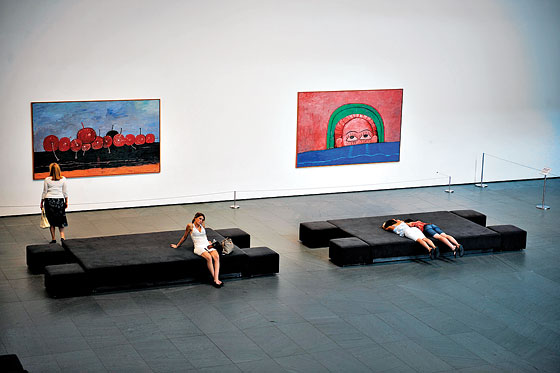Modern Machinery (original) (raw)

Photo: Stan Honda/AFP/Getty Images
The Museum of Modern Art has certainly not been in the same wayward state as the Guggenheim, but both faced crises of late. MoMA moved into its new home in 2004 and reinstalled its collection in a way that was as parochial as before. The Guggenheim, meanwhile, was planning, and then not opening, museums all over the globe. Now they both are getting new leadership. This is good.
MoMA promoted Ann Temkin to replace recently retired John Elderfield as chief curator of painting and sculpture. The job is huge. He—it’s never been filled by a she before—is the gatekeeper of modern art, responsible for telling the story of modernism, a story MoMA—given its collection—is capable of telling like no other museum in the world. However, the story MoMA has been telling is so outdated that no one except MoMA believes it anymore. It’s Old Testament art history: In the beginning there was Cézanne who begat Picasso and Matisse who begat all the way down the line to Pollock who begat MoMA’s most recent alpha male, Richard Serra. “I plan to take a broader, more international view than we did in the past,” Temkin told the Times. That’s code for “Good-bye to the European-American juggernaut. Good-bye permanent collection being less than 8 percent women.” She is also up to speed on international contemporary art. And with MoMA planning to build 40,000 square feet of new gallery space, she’ll have the room to present a bigger, more amazing epic than before.
Richard Armstrong, formerly the head of Pittsburgh’s Carnegie Museum of Art, is an unexpectedly perfect choice for the Guggenheim. For years, this museum has been under the thumb of director Thomas Krens, who built a swanky art palace in Spain and saw that as just the beginning. He wanted to create a “global brand” and bragged about being approached by “more than 130 cities” who wanted a Bilbao, too. But a museum isn’t easily franchised; it’s a place of ideas, not duplicated consumer experiences. While Krens gallivanted around the world, at home he mounted ridiculously unfocused exhibitions devoted to entire countries with which he wanted to do business (e.g., “Russia!”). I don’t know Armstrong well, but he seems to have a dash of what Baudelaire called the flâneur, a “gentleman stroller of city streets,” a “botanist of the sidewalk.” Caring but not caring. A tad flamboyant. He loves and participates in the life of art but never seems bent on bending it to his will.
Temkin is just a cog in the MoMA machine, but she represents a chance for it to feel relevant and alive again. Armstrong can, instead of wearing the Guggenheim down, allow it to hum again.
Have good intel? Send tips to intel@nymag.com.
Modern Machinery